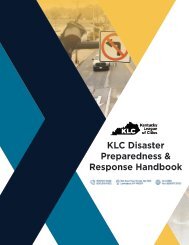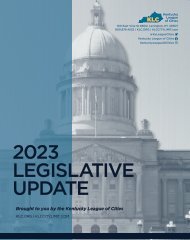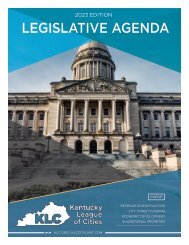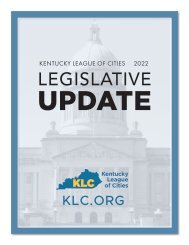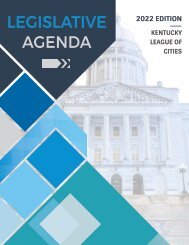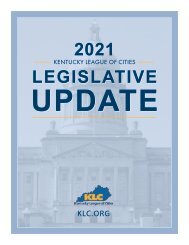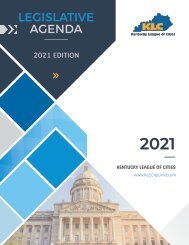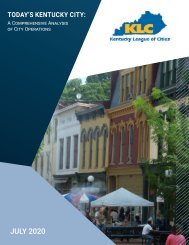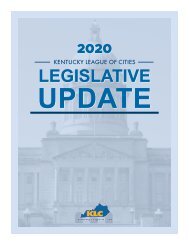KLC 2020 Legislative Agenda
Create successful ePaper yourself
Turn your PDF publications into a flip-book with our unique Google optimized e-Paper software.
ROAD FUNDING FORMULA
KLC Legislative Agenda 2020
As cities continue to do more with less, the high cost
of maintaining vital infrastructure becomes more of a
struggle. The condition of our city roads and bridges
directly impacts the ability of a community to grow and
attract new business. While the population of Kentucky
cities has continued to expand, the funding formulas
of important transportation networks have remained
unchanged for 48 years. It is critical that we modernize
these formulas to ensure transportation needs are met
in Kentucky cities.
LEGISLATIVE PRIORITY: Cities support adopting
a new road funding formula to ensure city
governments receive a fairer proportion of new
state gas tax revenues for the construction and
maintenance of city streets.
From Kentucky's smallest cities to Louisville and
Lexington, neighborhoods need reliable roads to
bring jobs and improve quality of life. Cities are the
economic engines of Kentucky and are often the heart
of the state's infrastructure network. They must provide
consistent, safe services while also dealing with slow
financial growth.
While transportation needs have grown, the method
used to pay for our vital infrastructure has not been
amended in decades. Since 2013, 27 other states have
increased their motor fuel tax revenue, including
nearby Indiana and Tennessee. Kentucky has remained
flat. Cities have seen spending on streets and roads
climb 17 percent since 2010, while state and federal
support has dropped 21 percent.
Money collected in the motor fuels tax goes into the
state's Road Fund, of which 48.2 percent is shared
between cities and counties. How those assets are
divided is largely determined by a system established in
1948 that is known as the "formula of fifths." It is heavily
slanted toward rural counties and has not changed
in 70 years. The formula allocates one-fifth equally
PAGE 5 OF 14
>>>>>>>>>>>
to all counties, one-fifth based on rural population,
one-fifth by rural road miles and the remaining twofifths
by rural land area. The formula does not account
for the population boom of cities nor the high cost of
maintaining those heavily traveled roads. In fact, it can
penalize counties with rapid growth.
The last update to the system was instituted in 1972
when the legislature created the municipal road aid
program. It has not changed since that time, despite
a sizeable increase in the population of Kentucky's
cities. Municipalities are now responsible for more
than 10,000 miles of public streets. State and federal
road revenue provides only about one-fifth of the cost
of maintaining those thoroughfares.
A proposal to update the state's road funding formula
acknowledges the growth and demand on city streets
by equally dividing motor fuels income over $825
million, the total available for sharing in Kentucky in
Fiscal Year 2014. The amount above that threshold
will be split between the municipal and county road
aid programs at 13 percent each. This will help ensure
cities, which are often the center of commerce and
activity in a county, can pay to keep high-traffic areas
safe while also holding counties harmless.
Currently, 61 percent of yearly vehicle miles traveled
in Kentucky are on rural roads, yet counties receive 85
percent of road aid revenue. Urban roads account for
39 percent of vehicle miles traveled, but cities receive
only 15 percent of the state's road aid allocations. It is
time the state modernized the road funding formula to
equalize distribution and ensure cities have the money
to maintain roads and bridges that often need more
frequent repair and maintenance.





